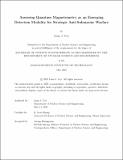Assessing Quantum Magnetometry as an EmergingDetection Modality for Strategic Anti-Submarine Warfare
Author(s)
Coy, Liam J.
DownloadThesis PDF (764.4Kb)
Advisor
Kemp, R. Scott
Terms of use
Metadata
Show full item recordAbstract
Emerging technologies have been a subject of much consternation in the nuclear deterrence communities as people fear they might erode secure second strike capabilities. One such emerging technology is the idea of ‘quantum magnetometry’—magnetic field sensors which use quantum principles in order to obtain more precise measurements. Nuclear submarines can be detected by the magnetic distortions they cause in the background Earth magnetic field. Quantum magnetometers could enable more precise measurements of such distortions. However, the lack of certainty around the potential for this emerging technology has led to a lack of clarity in policy circles. This thesis explores some limits on the impact of quantum magnetometry in the context of strategic anti-submarine warfare (ASW). It does this in two parts. First, it provides a survey of quantum magnetometry technologies and developments. Second, it characterizes the magnetic anomaly associated with a nuclear submarine (according to the best unclassified estimates of key parameters). It finds that while quantum magnetometers may indeed result in more sensitive magnetic anomaly detectors, their impact on strategic ASW will be limited. Firstly, the magnetic anomaly associated with a submarine scales as the inverse cube of the distance from the submarine. Thus, a ten-fold decrease in the minimum field necessary to detect a submarine would only provide a slightly more than two-fold increase in detection range. Improvements in detection range would have to be quite significant to have any strategic impact, due to the vast areas of the ocean required to search to find submarines. Secondly, magnetometers are limited by more factors than solely their sensitivity. There are signal processing issues involved in determining whether a change in measured magnetic field is as a result of a target or some form of environmental noise. As such, while quantum magnetometry may indeed improve submarine detection capabilities, it is unlikely to do so in a manner that impactfully destabilizes nuclear deterrence.
Date issued
2025-05Department
Massachusetts Institute of Technology. Department of Nuclear Science and EngineeringPublisher
Massachusetts Institute of Technology